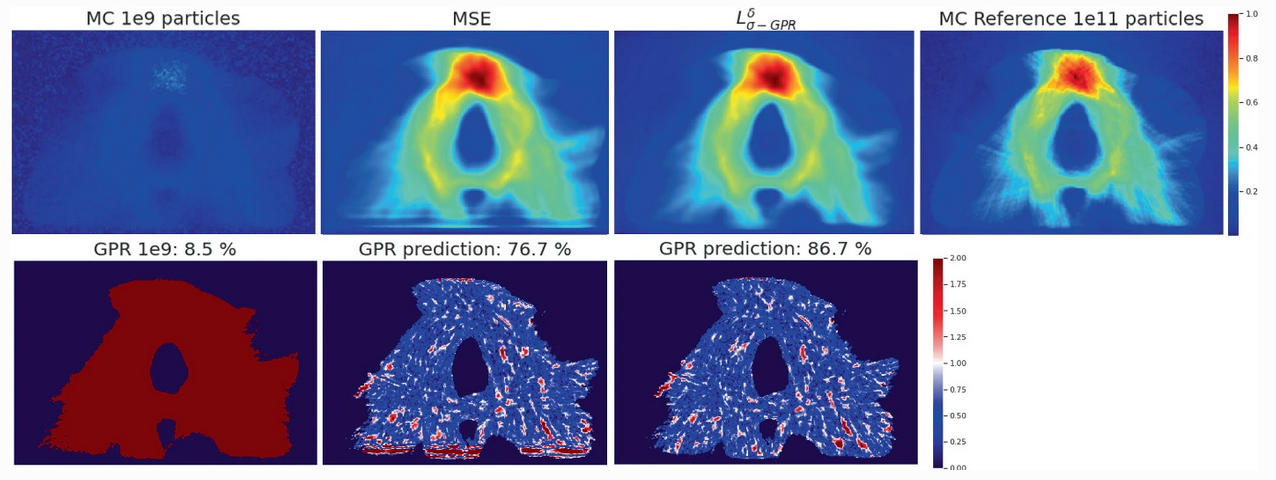computational radiology
Data-driven methods for radiology
Radiology could provide a non invasive way to address different diseases and treatments. Providing automatic tools for the analysis of radiology data could help on screening, diagnosis or even prognosis of radiologists during their clinical practice. Our team collaborates with the best clinicians to develop relavant methods for processing of radiology data. Currently, we have active collaborations with clinicians in APHP hospitals, Gustave Roussy and Henry Dunant Hospital towards this direction including Hagnodice, Prism, Noesia and Archimedes Unit projects.
Towards cancer treatment
- In Martinot et al. 2023 we introduce a new class of Gamma index Passing Rate (GPR)-based loss functions for training of deep learning methods towards radiotherapy dose simulation.

Comparisons of different predictons of radiotherapy dose presented in IPMI 2023 [Martinot et al. 2023].
- In Laousy et. al 2021 we propose a deep reinforcement learning method for accurate localization of the third lumbar area (L3) CT slice towards sarcopenia prediction.

Overview of the method presented in MLMI workshop of MICCAI 2021 [Laousy et al. 2021].
- In Sun et al. 2018 we proposed one of the first radiomics signatures for CD8 cells and we indicated a promising way to predict the immune phenotype of tumours and to infer clinical outcomes for patients with cancer who had been treated with anti-PD-1 and PD-L1

Results for head and neck tumors presented in Lancet Oncology 2018 [Sun et al. 2018].
Towards kidney transplantation monitoring
- In Milecki et al, 2023 ropose a framework that generates medical prompts using automatic textual data augmentations from LLMs. Our goal is to learn meaningful manifolds of renal transplant DCE MRI, interesting for the prognosis of the transplant or patient status.

Overview of the method presented in MIDL 2023 [Milecki et al. 2023].
- In Milecki et al. 2022 we propose a sequential architecture based on transformer encoders to predict the renal function 2-years post-transplantation, focusing on representation learning and missing data.

Overview of the method presented in MICCAI 2022 [Milecki et al. 2022].
Towards lung interstitial diseases
- In Chassagnon et al. 2021 we propose an automatic deep learning-based disease quantification using an ensemble of architectures, and a data-driven consensus for the staging and outcome prediction of the COVID-19 patients fusing imaging biomarkers with clinical and biological attributes.

Overview of the method presented in Medical Image Analysis 2021 [Chassagnon et al. 2021].
- In Chassagnon et al. 2021 we develop a deep learning–based method to depict worsening of ILD based on lung shrinkage detection from elastic registration of chest CT scans in patients with systemic sclerosis.

Results for ILD patients presented in Radiology 2021 [Chassagnon et al. 2021].
References
2023
- Differentiable Gamma Index-Based Loss Functions: Accelerating Monte-Carlo Radiotherapy Dose SimulationIn International Conference on Information Processing in Medical Imaging, 2023
2022
- Contrastive masked transformers for forecasting renal transplant functionIn International Conference on Medical Image Computing and Computer-Assisted Intervention, 2022
2021
- Deep reinforcement learning for l3 slice localization in sarcopenia assessmentIn Machine Learning in Medical Imaging: 12th International Workshop, MLMI 2021, Held in Conjunction with MICCAI 2021, Strasbourg, France, September 27, 2021, Proceedings 12, 2021
- AI-driven quantification, staging and outcome prediction of COVID-19 pneumoniaMedical image analysis, 2021
- Elastic registration–driven deep learning for longitudinal assessment of systemic sclerosis interstitial lung disease at CTRadiology, 2021
2018
- A radiomics approach to assess tumour-infiltrating CD8 cells and response to anti-PD-1 or anti-PD-L1 immunotherapy: an imaging biomarker, retrospective multicohort studyThe Lancet Oncology, 2018